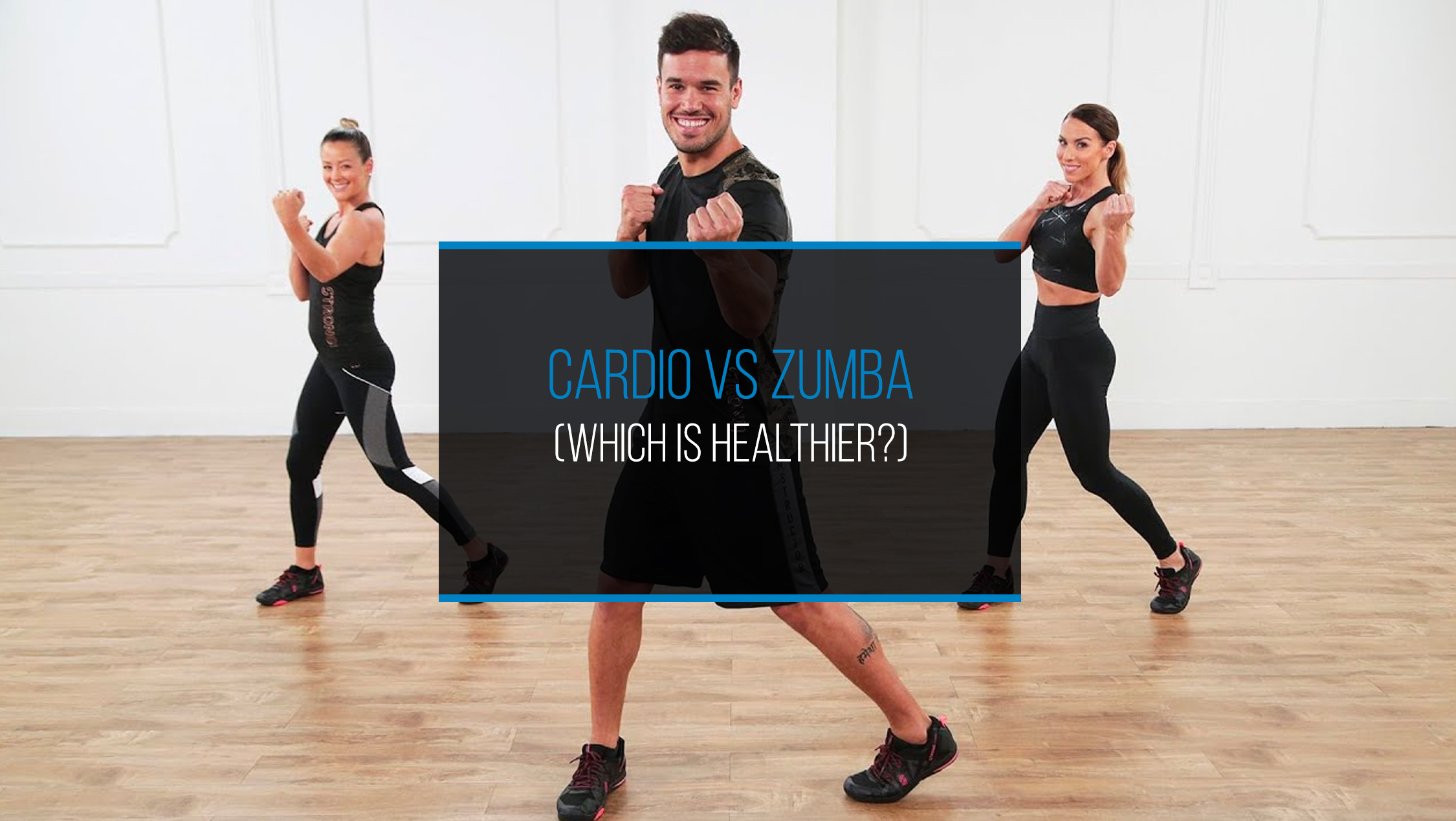
When it comes to choosing a new exercise routine, it’s only natural that you’re going to want to do something you enjoy while getting the best results and health benefits.
Cardio and Zumba are both designed to increase heart rate and are excellent ways to keep fit, lose weight and stay healthy. But which one comes with the most significant health benefits?
We found that Zumba has more health benefits than cardio alone because it incorporates some strength building which can help to improve flexibility, and it generally burns more calories per workout.
However, it all comes down to what is best for the individual, so, in this article, we’ll compare both kinds of exercises to help you find out which is most suitable for you. Including; the best for weight loss, heart health, strength, flexibility, and joint health.
What’s the Difference Between Cardio and Zumba?
Before we take a look at which kind of exercise is best for health, it helps to know the differences between the two and the potential benefits you can expect from each activity.
Cardio, also known as cardiovascular or aerobic exercise, is a form of repetitive activity that increases the heart rate.
This could be anything from vigorous yard work to running on a treadmill at the gym. Cardio can range from lighter activities such as fast walking to more strenuous exercise like running.
In comparison, Zumba is a dance workout incorporating cardio with moves such as lunges and squats while moving to a rhythm. The exercises used in Zumba use body weight to increase strength in some muscle groups.
Zumba is performed to Latin music, and workouts vary in intensity depending on the abilities of those taking the class.
Cardio and Zumba are both suitable for beginners and those with varying abilities. Exercises and routines can be made easier or harder depending on what you want to get out of a workout.
Cardio Benefits

It’s recommended that most people should do around 150 minutes of cardio exercise per week, broken down into regular sessions of about 30 minutes of activity.
When moderate cardio activity is performed regularly, you can expect to see the following benefits:
- Improved Heart Strength. In time and as the heart strengthens, it doesn’t need to work so hard.
- Increased Lung Capacity. This means the lungs can hold more air and make breathing easier during exercise.
- Decreased Blood Pressure. This can, in turn, reduce the risk of heart attack and other heart-related issues.
- Increased Weight Loss Through Fat-Burning. Regular cardio exercise is proven to help with burning fat, which can help with weight loss if used in conjunction with a healthy diet.
- Increased Mood and Lowered Stress. Cardio exercise is known to help improve mental health and can help to reduce stress, anxiety, and depression.
- Improved Sleep. Regular exercise helps you get better sleep, which helps to improve mood, brain performance, and health.
Zumba Benefits

Zumba workouts offer several health benefits, and because, like cardio, it’s a form of aerobic exercise, many of the benefits are the same.
If Zumba is your preferred choice of exercise, it’s recommended that you do two to three workouts per week to see the full benefits.
The list below shows the kind of benefits and improvements you are likely to see if you perform Zumba workouts regularly:
- Improved Heart Strength. The cardio element of Zumba increases the heart rate, making it stronger over time.
- Increased Lung Capacity. Just like cardio, regular Zumba workouts can help increase lung capacity.
- Decreased Blood Pressure. Improved heart health can help to reduce blood pressure.
- Increased Weight Loss Through Fat-Burning. A high-intensity Zumba workout is excellent for burning calories and can help with weight loss.
- Better Mood and Lower Stress Levels. Zumba is good for increasing mood while helping decrease anxiety and depression. The music element of Zumba is also great for lifting the mood.
- Improved Sleep. Regular Zumba can help with sleep, which has many health benefits.
- Increased Muscle Strength. Zumba can help increase muscle strength in certain body areas (depending on the style of workout).
- Increased Flexibility. Regular Zumba can help to improve flexibility in some cases (again depending on the workout).
- Improved Balance and Coordination. Improvements to overall strength can help improve balance and coordination over time.
Best for Weight Loss and Fat Burning
Winner: Zumba
Because they’re both forms of aerobic exercise, Cardio and Zumba workouts are excellent for burning calories and fat, which assist with weight loss when combined with a healthy diet.
The best weight loss results are seen when exercise is performed regularly and incorporated with a healthy diet.
To find out which is the best kind of activity for weight loss, let’s take a look at the average number of calories you can expect to burn with each type of workout:
The average amount of calories you can burn doing 30 minutes of cardio activity can range from around 145 to 295 calories. The number of calories you burn will depend on the type of exercise and the intensity in which it’s performed.
For example, if you do 30 minutes of moderate cycling, you can expect to burn around 145 calories, compared to vigorous cycling, which can burn 295 calories.
In contrast, during a 30-minute Zumba class, you can burn from 150 to 450 calories, depending on the intensity of the workout. Most Zumba workouts tend to be pretty high-intensity, so 450 calories is more of a realistic figure.
Based on this information, 30 minutes of Zumba burns more calories than most kinds of cardio exercise, which means it’s better for fat burning and has greater potential for assisting with weight loss.
Best for Heart Health
Winner: Joint Winners

Cardio and Zumba are both forms of aerobic exercise, which, if done regularly, can help to improve heart health.
Vigorous cardio can offer the same benefits as Zumba when it comes to heart health because they both help to increase the heart rate considerably.
Over time, regular aerobic exercise can help the heart become stronger so it can pump blood more effectively around the body.
This increased strength can help lower the resting heart rate and decrease blood pressure. All of which can help reduce the risk of heart attack and heart disease.
Cardio and Zumba are also good for increasing lung capacity, which means they can hold more air than before. In time, this makes exercise easier because you’ll be less breathless as you get fitter.
Best for Strength and Muscle Tone
Winner: Zumba
Although some forms of cardio activity can help increase muscle strength (such as cycling), others are not so good or might only help to increase strength in certain body areas.
To get a full-body workout, many people who do cardio workouts combine it with strength exercises to benefit from both forms of activity.
In contrast, Zumba combines strength exercises with cardio so that you can do the two forms of activity. However, it’s worth pointing out that there are better workouts for strength if you’re looking for more visible results.
Zumba classes tend to focus on key areas such as the legs, core, and glutes, so not all workouts can be considered ‘full-body.’
If strength is an important factor for you, you might want to consider ‘Strong by Zumba,’ which focuses more on building muscle. Some Zumba workouts also incorporate weights if this is something you’re interested in.
Best for Flexibility
Winner: Zumba

Neither cardio nor Zumba can be considered great for flexibility compared to other forms of exercise, but of the two, Zumba has more potential to improve flexibility than cardio.
Those who regularly perform cardio and want to improve flexibility often incorporate post-workout stretches that help increase flexibility or combine it with other forms of exercise (such as yoga or pilates).
Some kinds of Zumba moves will help stretch certain muscles, which over time can help with flexibility, but to get better results, you might need to focus on stretches separately.
Best for Joint Health
Winner: Joint Winners
Cardio and Zumba are both equally good for improving joint health for the following reasons:
- They can help to increase bone density. Weight-bearing activities such as running, cycling, and dancing (done regularly) are all good for improving bone density.
- Both kinds of exercise help with weight loss. If you’re partaking in regular exercise to lose weight, over time, this can help to take some pressure off joints (mainly the hips and knees).
- They help to increase muscle strength. Although there are better forms of exercise for muscle strength, some kinds of cardio and Zumba can help to increase muscle strength, which helps maintain healthy joints.
- Lubricated Joints. Low-impact cardio exercise and Zumba can help lubricate joints and strengthen connective tissues.
To get the maximum benefit for your joints, you need to be able to perform cardio or Zumba regularly (around two or three times per week).
Can Anyone Do Cardio and Zumba?
The good thing about cardio and Zumba is they’re suitable for those with a range of abilities.
Cardio activity can be done by almost anyone, from beginners to experts, because the type of exercise you do can be adapted to suit the needs of each individual.
For example, you might not be able to run, but walking a little faster than usual can still increase the heart rate and be considered a cardio activity.
With Zumba, some of the classes can be pretty intense, but if you’re looking for something with a slightly slower pace, there are plenty of lower-intensity Zumba workouts that you can do instead.
Some instructors will also show you how to make certain movements less intense if you’re struggling — it’s also a good idea to discuss any limitations with them before you begin.
If you have any existing health issues, always consult a doctor or medical expert before exercising for the first time or changing the kind of activity you do.
Risk of Injury
No form of exercise or activity is without risk; however, cardio and Zumba are both considered low-risk activities when it comes to injury.
Obviously, this depends on the kind of exercise and the intensity, but provided you’re sensible and don’t push too hard in the early days, you can limit the chances of injury.
It’s also essential to warm up properly before certain kinds of exercise, and most Zumba workouts will start with some more gentle activity before they start ramping up in intensity.
Always listen to your body; if something hurts or doesn’t feel right, it might not be the best activity for you.
Again — if you think you might be at greater risk of injury, check with a doctor first.
Final Comparison and Summary
So having compared cardio and Zumba in each category, Zumba has won the most categories for being the better option health-wise between the two. Including: best for weight loss, strength, and flexibility.
Cardio and Zumba are joint winners when it comes to heart and joint health.
- Best for Weight Loss: Zumba
- Best for Heart Health: Joint Winners
- Best for Strength and Muscle Tone: Zumba
- Best for Flexibility: Zumba
- Best for Joint Health: Joint Winners
It’s important to point out that although it didn’t win this comparison, cardio is still an excellent form of exercise that comes with many health benefits. Zumba just has a little more to offer because it combines an intense cardio workout with movements that can lead to more improvements in strength and flexibility.
Most Zumba workouts generally burn more calories than cardio activity, but of course, this depends on the intensity and how hard you work.
It really all comes down to which kind of exercise you think you’ll enjoy the most because if you find an activity boring, you’re less likely to stick to it long term.
Cardio comes with the benefit that you can do it almost anywhere, including outdoors, at home, or in the gym, whereas Zumba is more confined to group classes or DVDs. Zumba also has a cost element to attend classes, whereas cardio can be done for free.
If you like the idea of meeting new people and going to a class where an instructor can give you all the guidance you need, then Zumba is probably the better option for you.

